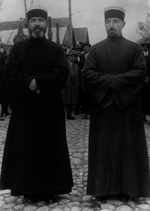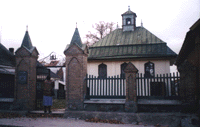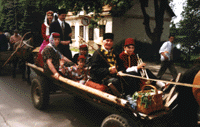Six hundred years two Turkish nations – Tatars and Karaims have been living in Lithuania. From linguistic and ethnogenetic point of view they belong to the oldest Turkish tribes – Kipchaks. This ethnonym (Kipchak) for the first time was mentioned in historical chronicles of Central Asia in the 1 st millennium BC. Anthropologically ancient Kipchaks were very close to Siberia inhabitants Dinlins, who lived on both sides of the Sajan Mountains – in Tuva and northern part of Gob.

Khadji Seraya Khan Shapshal
together with Simon Firkovich,
1930
In 5th cent. BC Kipchaks lived in the West of Mongolia, in 3 rd cent. BC they were conquered by Huns. Since 6 – 8 cent., when the first nomadic Turkish empires were founded, Kipchak’s fate is closely connected with the history and migration of the Middle Asia tribes.
In Middle Ages Kipchaks started to play an important role in the Eastern Europe. European historians and linguists call them Kumans; Russian scientists call them Polovtsy. In Turkish literature they are known as Kipchaks.
Following after Turkish oguzes, who were the biggest Turkish tribe, in 10 th cent. Kipchaks crossed the Volga and settled in steppes near the Black Sea and Northern Caucasus. Huge territories occupied by Kipchaks from the West of Tian- Shan to the Danube, in 11-15 th cent. were called Dest-e-Kipchak (Kipchak’s steppes). They did not have an integral state; khans guided the union of different tribes.
Khasar’s kaganate, spread over southern territories of contemporary Russia, in 9 th cent.being at its blossom, was famous for its religious tolerance. Karaim missionaries reached the kaganate in 8 – 10 cent. passed their faith to some Turkish tribes (Khasars, Kipchaks-Kumans, and others), living in the southern steppes of Russia and Crimea. Common language and religion united these tribes as a nation for a long time; the name of religion became ethnonym. Contemporary Lithuanian Karaims are the descendants of those tribes.


1997
The Karaims of Crimea, Galich-Luck area, Lithuania and Poland who have common origin, past, religion, language (with dialects), spiritual and factual culture, make the same nation.
The history of Karaims is connected with Lithuania since 1397-1398. According to the tradition, The Great Duke of Lithuania Vytautas, after one of the marches to the Golden Horde steppes, had to bring from Crimea several hundreds of Karaims and settle them in the Great Duchy of Lithuania. Vytautas could bring Karaims after he had beaten one of the hordes not far from Azov. Transference of several hundreds Karaim families and several thousands of Tatars was not done once. It was connected with the state policy of The Great Duchy – to inhabit the empty areas, to build towns and castles, to develop trade and economic life.
Initially, Karaims were settled in Trakai between two castles of The Great Duke, present Karaim Street. Later they were found living in Biržai, Naujamiestis, Pasvalys, Panevėžys, however, Trakai has always been the community’s administrative and spiritual centre in Lithuania. Karaims themselves began to hold it not only a homeland, but as fatherland, too. Throughout the centuries their ethnic and cultural relations with the Karaims from Crimea and Galich-Luck areas were not interrupted either.
In order to get thorough information about Karaims’ social, cultural, ethnic and religious situation, in 1997 The Statistics Department of Lithuania carried out the ethno-statistic research “Karaims in Lithuania”. It was decided to question all adult Karaims and mixed families, where one of the members is a Karaim. During the survey, i.e beginning 1997 there were 257 Karaim nationality people, 32 among them were children under 16.
The change in the number of Karaims during the period of 40 years is shown:
| 1959 | 1970 | 1979 | 1989 | 1997 | |
| Total number of Karaims | 423 | 388 | 352 | 289 | 257 |
| Palyginti su visu gyventojų skaičiumi, % | 0,02 | 0,01 | 0,01 | 0,01 | 0,01 |
Distribution of Karaims by age and sex:
| Karaimes | Male | Female | ||||
| Iš viso | % | Iš viso | % | Iš viso | % | |
| Total | 257 | 100 | 132 | 100 | 125 | 100 |
| of whom by age groups, years | ||||||
| below 16 | 32 | 12.4 | 14 | 10.6 | 18 | 14.4 |
| 16-29 | 38 | 14.8 | 21 | 15.9 | 17 | 13.6 |
| 30-39 | 30 | 11.7 | 17 | 12.9 | 13 | 10.4 |
| 40-49 | 31 | 12.1 | 17 | 12.9 | 14 | 11.2 |
| 50-59 | 50 | 19.4 | 34 | 25.8 | 16 | 12.8 |
| 60 and above | 76 | 29.6 | 29 | 21.9 | 47 | 37.6 |
According to the living place:
| Total | of whom children below 16 years | |
| Total | 257 | 32 |
| Vilnius | 138 | 20 |
| Trakai | 65 | 9 |
| Grigiškės (Trakai region) | 6 | 1 |
| Lentvaris (Trakai region) | 4 | 1 |
| Kaunas | 4 | – |
| Noreikiškės (Kaunas region) | 4 | – |
| Panevėžys | 31 | 1 |
| Naujamiestis (Panevėžys region) | 2 | – |
| Pasvalys | 2 | – |
| Šeduva (Radviliškis region) | 1 | – |

